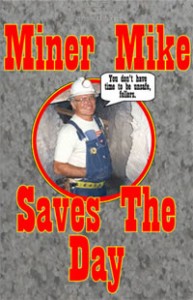Saving Miners’ Lives with Video-based Training
Posted on by How do you take miners miles below ground to teach them how to protect themselves from some of the most dangerous hazards in the mining industry without endangering their safety or ever leaving the comfort and security of the training room? The answer, training videos.
How do you take miners miles below ground to teach them how to protect themselves from some of the most dangerous hazards in the mining industry without endangering their safety or ever leaving the comfort and security of the training room? The answer, training videos.
Videos have proven to be an excellent training tool. They offer the ability to provide information about the work environment, especially dangerous work environments, without putting the trainee at risk. When properly executed, videos are much more interesting than the “talking head” lectures that often make up a training session. The National Institute for Occupational Safety and Health has a number of videos available on its website covering a variety of topics such as stress, violence on the job, and TB respiratory protection. The majority of videos deal with mining topics.
Mining is the most dangerous industry in the U.S. In 2006, the overall mining fatality rate was 27.8 per 100,000 full-time equivalent workers, compared to a fatality rate of 4.2 for all private industry (BLS). Safety training is imperative. Not only is it federally mandated, but its importance is widely recognized in preventing injury and death. The question is: How do we most effectively train a group of workers who tend to learn their trade in a master-apprentice relationship in a mine versus reading training manuals in a classroom? Training concerns were echoed in stakeholder meetings held by NIOSH’s Spokane Research Laboratory (SRL) where partners voiced concerns about significant gaps in training materials for new and experienced miners and called for new, effective materials.
One good solution pursued by SRL is the use of quality training videos—specifically, story-based videos. Miners are born story tellers. They share “near-miss” stories as well as stories about master miners they have known. These stories not only pass along information about what will happen if a miner fails to respect the mining environment, they also instruct listeners in the culture of mining, the values it embraces, and what is expected of new hires.
Additionally, the decision to use older, wiser miners in our training videos as the storytellers was based on research that shows adults learn from watching the experiences of others (particularly people who are admired or viewed as mentors, teachers, coaches, etc.) and from mentoring they received from someone they perceived to be both knowledgeable and wise. In a review of one mining video, Zen and the Art of Rock Bolting, on a mining blog the author states: “The genius of this movie is the old miner. NIOSH wisely chose a real miner with 40 years experience. What an engaging fellow. Rough yet wise. Careful yet casual. Devoted to mining and what it brings: competition, money, and the rapid passage of the work hours.”
The videos were all shot in operating mines using real miners as actors—a notable difference from older training films that tended to use either actors or government workers. Since these people didn’t walk or talk or look like miners, they didn’t usually have credibility in the eyes of the trainees.
To date, eleven videos have been produced by SRL. Seven training videos deal with underground hard-rock mining covering topics such as ground control methods, working with explosives, and recognition of roof, and mobile equipment hazards. Two videos, Hidden Scars and You Are My Sunshine, depict a fatal accident and a major mining disaster in documentary-style stories. Another, two videos, The Sky Is Falling! and Aggregate Training for the Safety Impaired target the hazards miners face in surface mines. Tame the Flame, a video presently in production, addresses the dangers of using cutting torches and welders in underground, gassy coal mines. SRL has also produced a video for commercial salmon fishermen called The Most Powerful Thing, which discusses deck safety on purse seining vessels.
As part of the SRL mining safety training video project, the first five videos were evaluated by an independent research team. All videos rated high on the evaluation criteria—quality, credibility, content, effectiveness, and engaging nature. In addition, miners enjoy watching them and many have taken the videos home to share with friends and family.
While all of the videos produced by SRL (except The Most Powerful Thing) deal specifically with miners, the lessons learned about how to best reach this audience can be applied to other groups, particularly workers who work in high risk environments and whose culture and learning style may be similar to that of miners.
A list of all NIOSH videos and ordering information can be found on the NIOSH website. Single copies of videos in VHS or DVD format are available free of charge and many can be downloaded, or viewed online. Recently, NIOSH began placing safety and health videos on YouTube to reach a wider audience.
More information on using stories as effective training tools can be found in the document Tell Me a Story: Why Stories are Essential to Effective Safety Training.
Elaine T. Cullen, Ph.D.
Dr. Cullen is the founding Communications Branch Chief at NIOSH’s Spokane Research Laboratory. She continues making videos for high-risk industries with her company, Prima Consulting Services, Inc.
Posted on by

